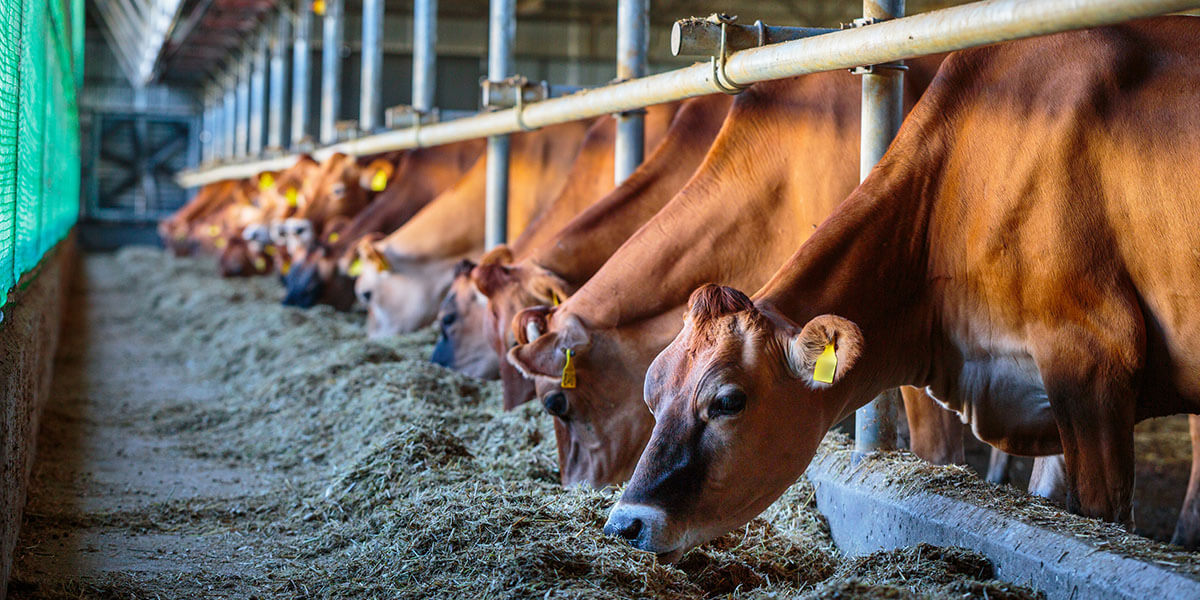When it comes to copper supplementation in dairy cow nutrition, dairy producers need to make sure they are meeting the animal’s needs for optimal performance, while at the same time, making sure that supplementation levels aren’t high enough to cause excessive copper accumulation in the liver.
Copper is a critical component of a variety of metabolic and structural functions within dairy cattle, including the following:
- Melanin pigment formation
- ATP production
- Iron absorption and metabolism
- Red blood cell maturation
- Immune function
- Disulfide bonding and keratin proteins
- Collagen formation
If over-supplemented, however, copper can become toxic. In cases of extreme over-supplementation, the liver will accumulate high levels of copper. Cows may not show signs of this until a stressful event that requires increased catabolic liver activity triggers the release of an immense amount of copper into the blood (hemolytic crisis), which could lead to the following:
- Considerable hemolysis, which is the rupturing of red blood cells, releasing hemoglobin into the blood and, therefore, decreasing the amount of oxygen in the body.
- Jaundice, which is the result of excess amounts of the pigment bilirubin in the blood.
- Widespread necrosis, which is the death of most or all of the cells in an organ or tissue due to failure of the blood supply.
- And even death.
Industry liver sample results from several sources indicate that even moderately elevated levels of copper supplementation can be problematic. This makes assessing copper status at the herd level critical.
Determining Copper Status
Hepatic tissue is the ideal indicator of copper status in animals and reflects the long-term availability of dietary copper (Herdt and Hoff, 2011). Copper binds to metallothionein in the liver, which is important because excessive free copper in the liver can damage hepatic lipid membranes and copper is a pro-oxidant.
Adequate liver copper content levels are between 75 ppm and 300 ppm dry weight basis (Puls, 1994). In the past, concerns about excessive copper accumulation did not arise until levels exceeded 750 ppm dry weight, but there is evidence that producers should take a closer look at the amount of supplementation if hepatic copper levels exceed 500 ppm dry weight.
Lyman et al. (2015)
found that hepatic copper concentrations in cull dairy cows averaged
approximately
500 ppm, and many of those samples showed signs of lipid membrane peroxidation.
Schefers (2015) explained how blood liver enzyme levels were elevated when
hepatic copper concentrations were greater than 450 ppm, which indicated some
hepatic damage.
Random liver samples collected by Zinpro from healthy, mid-lactation dairy cows between 2000 and 2017 show that the hepatic copper concentration for these randomly sampled cows are right on the borderline for concern. Looking deeper, however, you can see a significant number of cows with much higher levels.
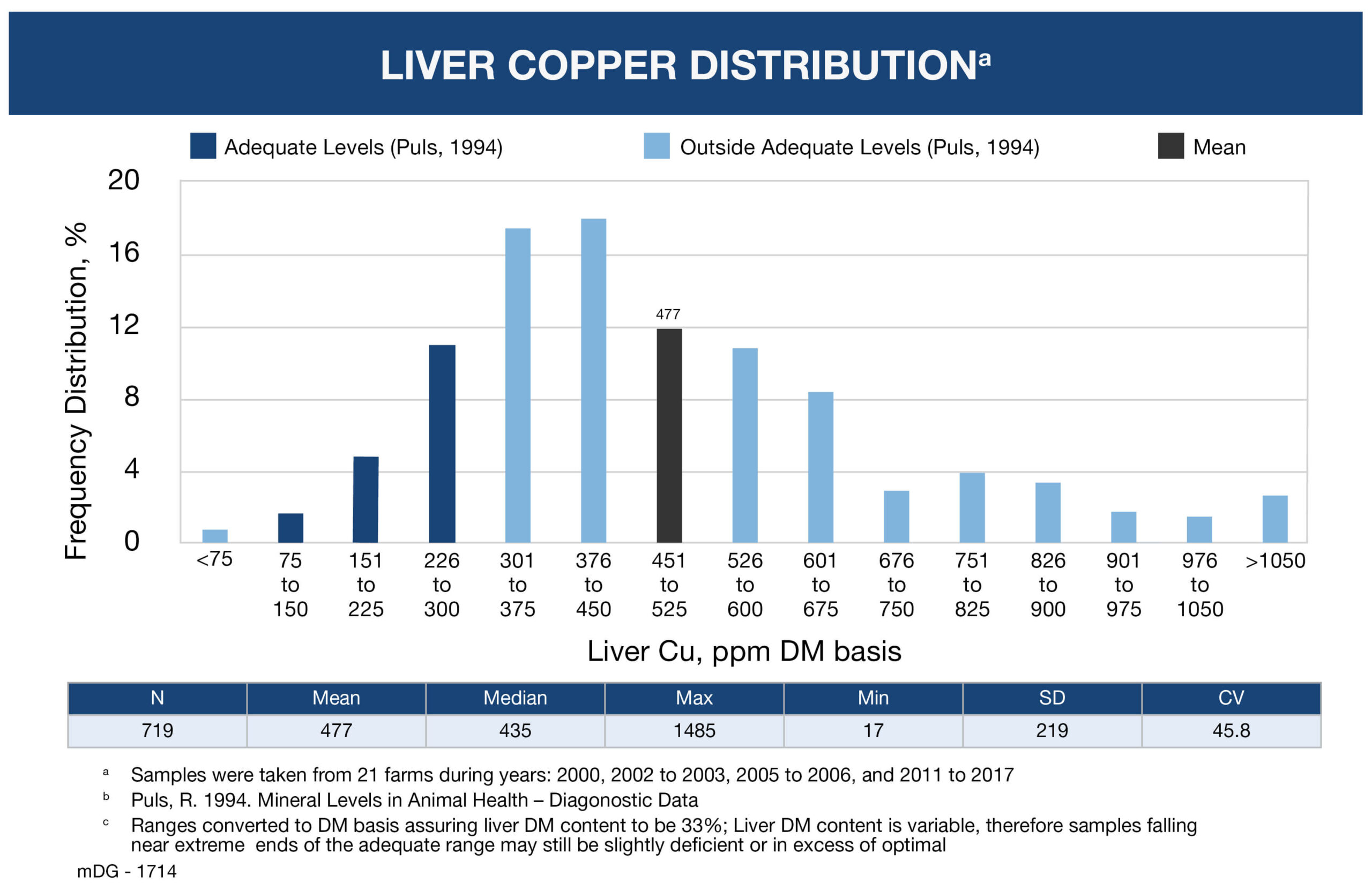
Potential Causes of Excessive Copper Accumulation
There are several factors that could be contributing to excessive copper accumulation. Maintenance and pregnancy are the main drivers of the copper requirement and, to a lesser extent, milk production. However, today’s dairy cows are eating more dry matter than in years past due to higher milk production. A cow that eats 60 pounds (27 kg) of dry matter will consume an extra 90 mg of copper per day compared to a cow consuming just 50 pounds (23 kg), assuming a level of 20 ppm of total dietary copper. This may not seem like much, but it makes a significant difference over the lifetime of a cow. Additionally, as feed intake increases, so does the feed passage rate, reducing the exposure time copper has to antagonists (molybdenum and sulfur), which may result in greater copper absorption.
Hepatic concentrations of copper increased by approximately 230 ppm dry weight when lactating dairy cattle are supplemented with 12 to 15 ppm copper across two lactations (Nocek et al., 2006). The only time that liver copper tends to decrease during the lifetime of a cow, outside of purposely removing copper supplementation, is during the dry period. This may be due to a combination of meeting the needs of the developing calf and the fact that dry matter intake is up to 50 percent lower compared to a lactating cow. However, soon after calving, copper accumulation begins to occur again and often exceeds the level maintained in the previous lactation.
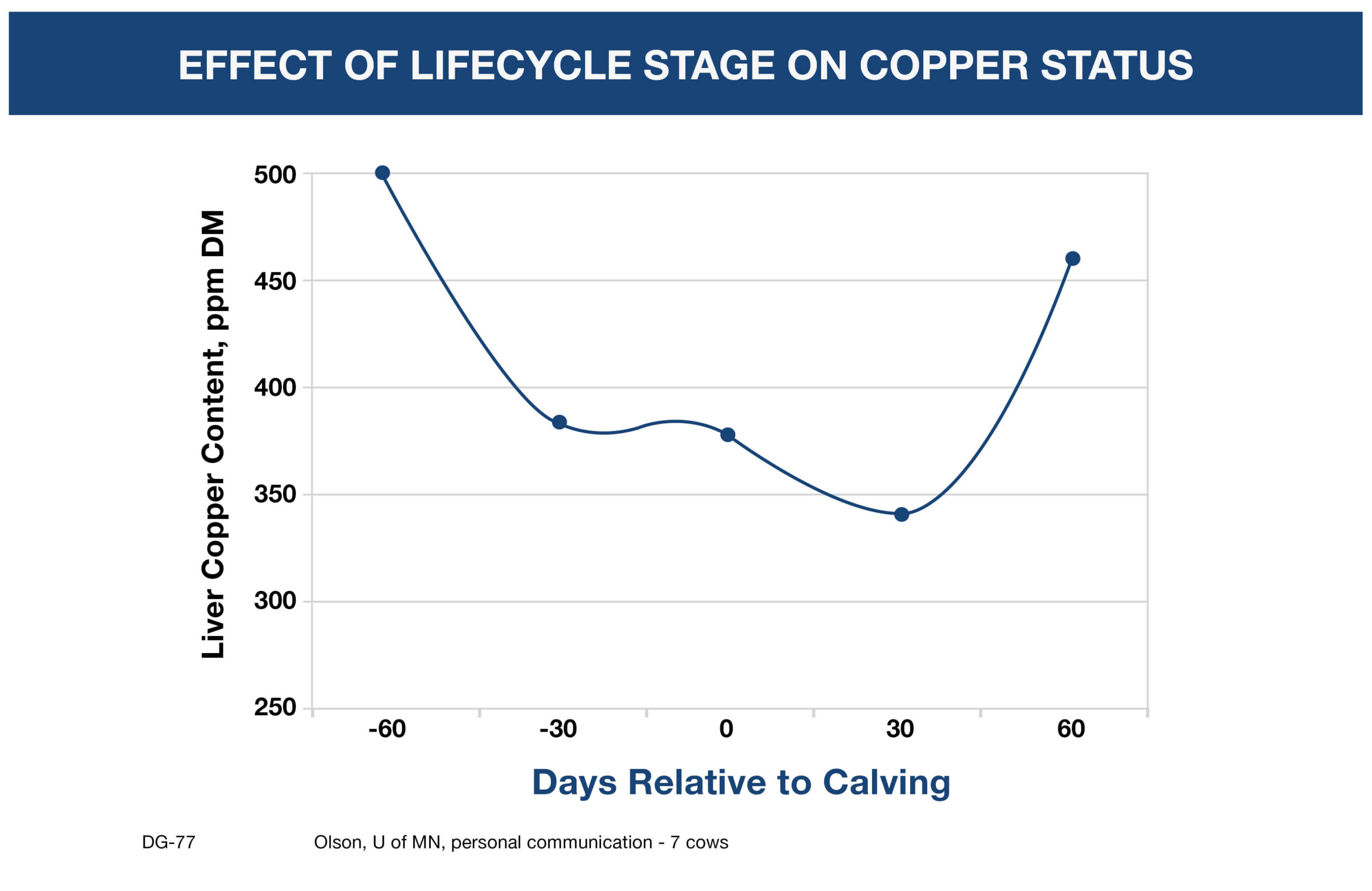
Another possible cause for excessive copper accumulation is that nutritionists may be using book values instead of analyzed values for minerals. Using book values is strongly discouraged because trace mineral content can be highly variable based on different farm conditions, including concentration of mineral in the soil, soil pH, geographical location, soil contamination during harvest and forage type. Legumes accumulate greater levels of Cu compared to grasses, therefore, different forage crops would have different sensitivity to Cu accumulation.
The use of copper sulfate footbaths on a farm could also be a contributing factor to excessive copper accumulation. It is estimated that a 1,000-cow dairy that runs a 5 percent copper sulfate footbath three times per week will be contributing about two tons of copper to the manure each year, which is then spread onto the field. Manure is often spread on land closest to the farm, so there can be an effective field accumulation in this scenario.
Even though copper accumulates throughout the animal’s lifetime, concern over this issue is not limited to older dairy cattle. Kendall et al. (2015) observed that liver copper levels in cull dairy cows did not differ by age once cows reached two years of age (2 to 15 years of age). Gomez et al. (2014) found Holstein steers between 300 to 600 pounds of bodyweight to have liver copper levels in excess of 500 ppm dry weight. Lyman (2013) presented case studies where heifers under 550 pounds and steers under four months of age already presented signs of copper toxicity. Accumulation of copper may start in utero as Graham et al. (1994) found liver copper levels to be similar between dams and fetuses. Furthermore, reports from the field have indicated liver copper levels in newborn Holstein calves to exceed 500 ppm dry weight in some cases.
Meeting the Copper Needs of the Animal
In most cases, trace mineral supplements should provide 8 ppm to 10 ppm supplemental copper to Holstein cows and heifers, with the caveat to not exceed 400 mg of total dietary copper per day. Zinpro research shows that providing more than 400 mg of copper per day may result in liver copper levels exceeding 450 ppm dry matter regardless of whether the source of copper was inorganic, or from performance trace minerals (Kellogg et al., 2003, Ferguson et al., 2004, Nocek et al., 2006, Ballantine et al., 2002, Griffiths et al., 2007, Siciliano-Jones et al., 2008, Hackbart et al., 2010).
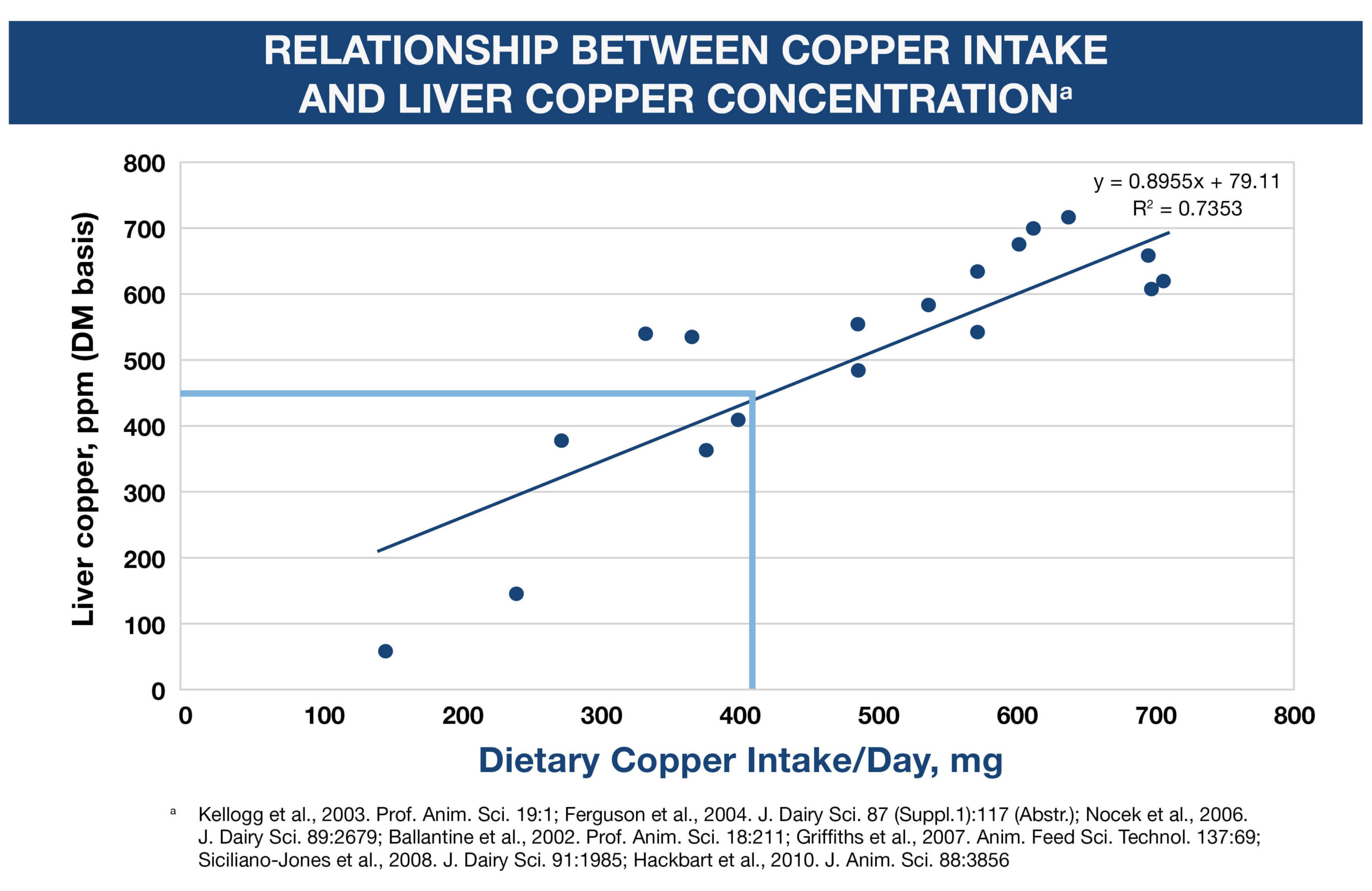
Jersey cows and heifers are more efficient at accumulating copper in the liver (Du et al., 1996), so one should limit supplementation to 6 to 8 ppm, or a total dietary maximum of 300 mg of copper per day.
Finally, 3.5 to 5 ppm of the supplemental copper should come from a source that is less susceptible to stress and antagonists. Including copper complexed with an amino acid, such as Availa® Cu, to stressed dairy cattle improves copper retention compared to inorganic copper sulfate. This suggests a different metabolic activity when copper is administered as Availa Cu.
To ensure their dairy cattle are getting the correct amount of copper, nutritionists should take a water sample at least once per year to stay alert of potential antagonists, like iron or sulfates. Then, they should maintain a library of feedstuffs that includes trace mineral analysis for their dairies, instead of using book values. This will provide a reliable benchmark on where basal copper and antagonist levels are within a farm or region. When dietary molybdenum and sulfur levels are high, one may need to alter the previously mentioned recommendations. One way to do this is by maintaining a Copper:Molybdenum ration of 4:1, particularly when sulfur levels exceed 0.3 percent. As shown on the table below, when sulfur levels are closer to 0.2, this alteration is less necessary. Also, if diets are high in both molybdenum and sulfur, thus conditions are favorable for the formation of thiomolybdates, producers should consider providing a portion of the supplemental copper from a rumen available copper source to reduce absorption of thiomolybdates. Absorbed thiomolybdates will prevent absorbed copper from being metabolically available.
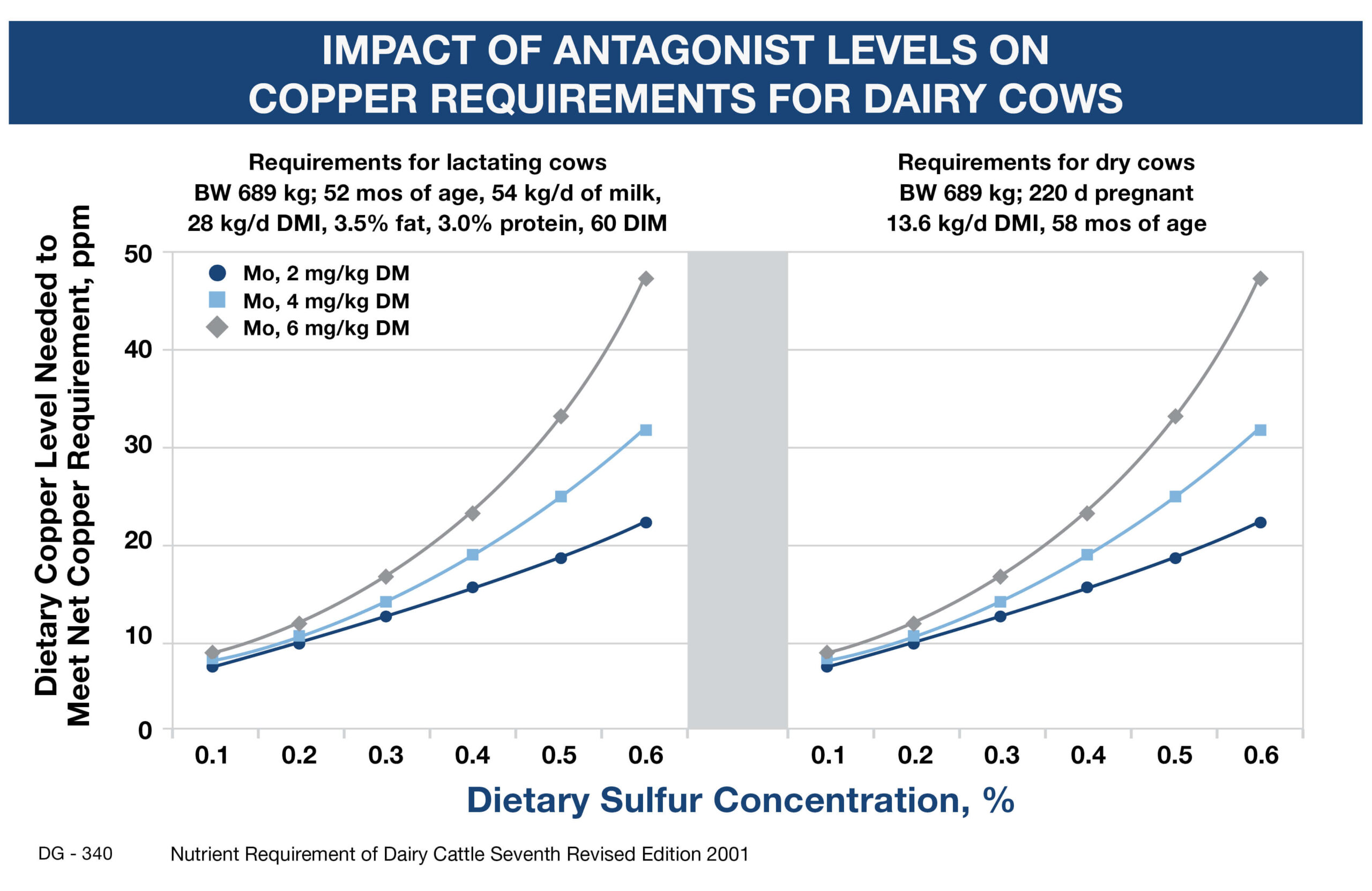
Copper is an essential nutrient required for numerous biological functions, but it’s also possible to have too much of a good thing. Considering the factors of greater feed intakes and higher basal copper levels in the diets, and excessive copper accumulation in hepatic tissue, diets need to be accurately designed for copper supplementation.
To learn more about appropriate copper levels for dairy cattle, or to ask about including Availa Cu in your dairy cattle nutrition program, contact your Zinpro representative today.

